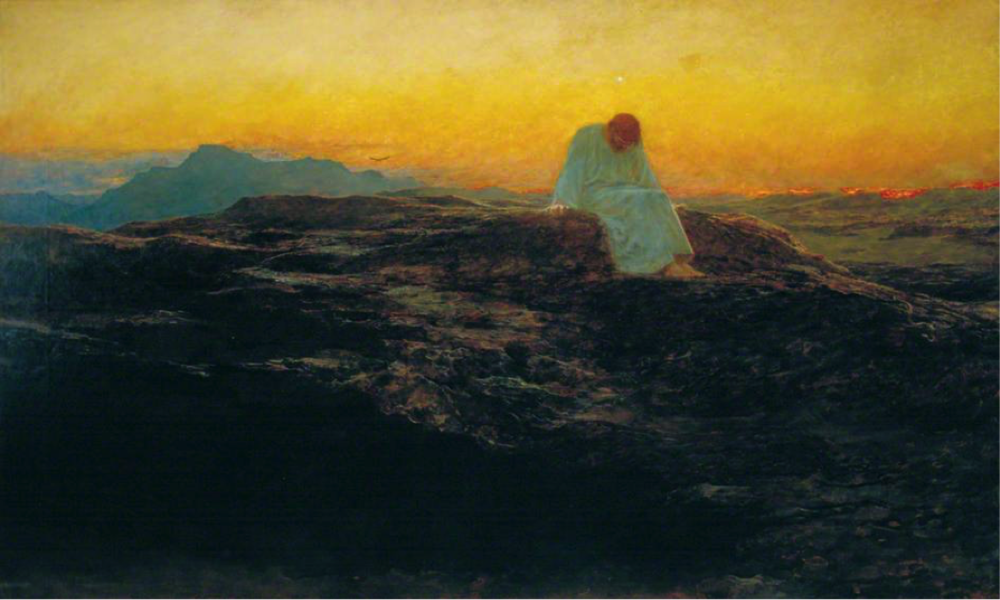JOURNALING - HEARTBEAT OF GOD
Archived series ("HTTP Redirect" status)
Replaced by: Salt House - Sermons
When?
This feed was archived on June 07, 2018 00:40 (
Why? HTTP Redirect status. The feed permanently redirected to another series.
What now? If you were subscribed to this series when it was replaced, you will now be subscribed to the replacement series. This series will no longer be checked for updates. If you believe this to be in error, please check if the publisher's feed link below is valid and contact support to request the feed be restored or if you have any other concerns about this.
Manage episode 173840444 series 1071952
March 5, 2017 / LISTENING FOR THE HEARTBEAT OF GOD - JOURNALING / Sara Wolbrecht / Matthew 4:1-11
Friends, today through our sermon time we’ll orient ourselves in our particular journey together for Lent – saying a bit about how to posture ourselves in these next six weeks. Our journey we are on as we practice daily prayers from the book Prayer: Forty Days of Practice. We started on Wednesday with our readings (how is it going?) – but anyone can join anytime. Please buy a book today if you have not already – and be sure to hang on to, bring home, the Lent insert in your bulletin. It includes our reading schedule, a schedule of other important events, and some grounding language for us on our journey.
If you are doing the reading, then you may have noticed that today’s reading includes the first of our six practices. Journaling. We’ll get to practicing a form of that in a few minutes.
But first, we set, what I want to call our posture for Lent – the way we can hold ourselves in these 40 days, how we orient ourselves. Describing the path that is before us. And we’ll begin with a passage from the bible, from one of Jesus’ biographies, a section often titled “The Temptation of Chrsit,” a passage read today, this first Sunday of Lent, in mainline churches around the world.

We won’t have the text on the screen (as we usually would), but will try hearing and envisioning what we hear (If you do want to see the words, it’s printed on the back of your bulletin insert). I invite you to listen, with a painting, called The Temptation in the Wilderness, by a late-19th-Century British painter, Briton Rivière, to focus our hearing.
Matthew 4:1-11 (MSG) Next Jesus was taken into the wild by the Spirit for the Test. The Devil was ready to give it. Jesus prepared for the Test by fasting forty days and forty nights. That left him, of course, in a state of extreme hunger, which the Devil took advantage of in the first test: “Since you are God’s Son, speak the word that will turn these stones into loaves of bread.”
Jesus answered by quoting Deuteronomy: “It takes more than bread to stay alive. It takes a steady stream of words from God’s mouth.”
For the second test the Devil took him to the Holy City. He sat him on top of the Temple and said, “Since you are God’s Son, jump.” The Devil goaded him by quoting Psalm 91: “He has placed you in the care of angels. They will catch you so that you won’t so much as stub your toe on a stone.”
Jesus countered with another citation from Deuteronomy: “Don’t you dare test the Lord your God.”
For the third test, the Devil took him to the peak of a huge mountain. He gestured expansively, pointing out all the earth’s kingdoms, how glorious they all were. Then he said, “They’re yours—lock, stock, and barrel. Just go down on your knees and worship me, and they’re yours.”
Jesus’ refusal was curt: “Beat it, Satan!” He backed his rebuke with a third quotation from Deuteronomy: “Worship the Lord your God, and only him. Serve him with absolute single-heartedness.”
The Test was over. The Devil left. And in his place, angels! Angels came and took care of Jesus’ needs.
Can you picture it? Feel it? Jesus, tired, alone, exhausted, and yes, starving. Satan, the tempter, tries to take advantage of that, offering Jesus all the good stuff. For any of us in that kind of state – we would be vulnerable at those times of exhaustion to do our worst. A picture of an entire box of Girl Scout Cookies comes to mind for me. But we see how Jesus doesn’t do his worst. Even in his exhaustion and hunger, he is grounded. And yes, he’s Jesus, but something sustains him. Our question today, with this text, is: What sustains Jesus?
Hold this question for a moment, ok? As we jump to the year 664 in Britain. Are you there mentally? I want to share the first page of a book on Celtic Spirituality by John Philip Newell, where he captures a moment in the history of Christianity, that sent our tradition as we know on a certain trajectory. There are a good number of British names and locations included, but try to keep up. I read this a few weeks ago, and was stunned to hear about this historical moment that changed the shape of Christianity as we know.
Excerpt from, “Listening for the Heartbeat of God: A Celtic Spirituality, “ p. 1-2
Isn’t that stunning! I had not heard this piece of Christian history in my seminary classes – and I feel so stirred up and identify with this image and way of seeing that the Celtic mission emphasizes.

This memory of John reclining against Jesus, that in this intimate moment, he heard the heartbeat of God. Thankfully, although Celtic spirituality did go into decline, there is still a thread of it woven through the centuries. A thread that continues to hold the memory of John, the Beloved Disciple, leaning against Jesus at the Last Supper. A thread of the Christian tradition that holds as central this posture of John, a posture of listening, to hear the heartbeat of God.
My friends, I want to suggest that this is the posture for us to take this Lent, together. John became an image of the practice of listening. Listening for the heartbeat of God. This listening is deeply rooted in the belief that we are made in the image of God, and that the sacred heartbeat is within us, and within one another, and deep within the body of the Earth.
This posture invites us to be attentive to the sacred essence within ourselves, but also invites us to listen in a new way to one another – to believe, even, that the heartbeat of God is there in other religious traditions, those in other racial groups, those in other nations, those who seem so different than us. Invites us into a sense of relationship with every life form, everything that has being. Which feels deeply sacred and humbling to take on this posture. But this posture is what I invite us into for Lent. Listening.
So I invite us to hold that picture of John with Jesus close as a posture of listening for us to emulate. Or in addition to that image, maybe another reminder would be this image: a stethoscope. Our kids in Salt House Kids are each getting their own stethoscope to take home, after talking together about how the heartbeat of God can be heard in ourselves and each other and the earth. And this is a good image for us to carry, too – to imagine ourselves always, always, with our stethoscope. Always listening for that heartbeat of God, in ourselves, in all the places and spaces we go, in all whom we encounter, even at times when it takes persistence to find it and hear it.

This is our posture for Lent: listening for the heartbeat of God. (BOTH: pic of stethoscope – alongside John the Beloved). Both of these images - of John, of a stethoscope. And this then, is the posture we carry in our practice of prayer. That we not only hold the prayers we read each day in our book – but we hold ourselves open to hearing God, too.
I do want to emphasize what the author, Justin, articulates in the introduction – that prayer is not something that needs to take a certain form or be “done right.” But it is a practice. Prayer takes practice, it is never in a finalized form. So with our stethoscopes, we get to practice prayer, together. (A bit of a spoiler alert: this posture practice of prayer: it ain’t just for Lent, right?).
Now, remember our question from our text? Jesus in the wilderness, starving, and SOMETHING sustained him? I think the something was Jesus’ own stethoscope. Being so in tune with the words and promises and heartbeat of God, that Jesus could tap into that even when presented with an entire box of Girl Scout Cookies – or the other things Satan offered. So much comes at us, all the time – that we, like Jesus, are often so exhausted and hungering. This Lent, we explore what it means to be sustained in prayer, like Jesus.
To close our time, we’ll turn now to our first prayer practice of Lent, that of journaling. Are you a journaler? Or seasons of journaling in your life?
I commend to you Justin’s reflection on the practice of journaling – read it today if you haven’t yet. But he names it – that so often we don’t know HOW to listen to our lives – and yet the simple practice of writing things down, will open up our posture of listening, to notice, and remember moments of significance in our lives. To hear what God is saying.
Here’s the question for you: this week, what might it look like for you to take time to write things down – only YOU can answer this question of how/what journaling would be. What method would work well for you? A small pocket notebook in your pocket or purse? A journal on your nightstand for end-of-day reflections? Making notes on your computer, or phone or in a journaling app? I encourage you to answer that question of what and how, and make a commitment before you leave today – especially if it means stopping at the store to pick up a journal on your way home. Make it happen for you to be able to try journaling this week.
And for our practice here, together, I invite you into a particular experience of journaling. I call it “A Conversation with God.”
I’ll explain it in a moment, but under your seat are the tools you need to do this: a hymnal to serve as your hard writing surface, paper tucked in the front cover, and a pen for most (use one of your own if you have one). As I continue to explain, raise your hand if you need any of those supplies – and multi-task by also listening.
You can do this anytime when you have pen and paper – or even your computer. Folks watching, here’s how to set it up. You turn your paper the tall way, draw a line down the middle to make two columns, then write at the top, on the left, “Me” and on the right “God.”
And then you begin to have a conversation with God. Starting with a question is a good way to go – particularly something you’ve really wanted to know the answer to. Write your question down in the ME column. And without giving it too much thought, move right over to God’s side of the conversation, and see what God responds with. Write it down. Then move back, your response. Keep you writing small. Moving back and forth, for as long as the conversation will go. We have extra sheets at the entry table if you use up the front and back. Feel free to move to another space, spread out to an empty seat or even sit on the floor if you need more room. Find a space that’s comfortable.
We’ll have five minutes, then the music will start to signal that we’re wrapping up. But you are welcome to keep writing during communion, as well.
The first time I tried this I was 19 years old, and it was astounding to experience how the heartbeat of God pulses in me in such a way, that God actually said some beautiful things over the course of that first conversation. What might we hear to sustain us as we listen, and pray, together?
100 episodes




